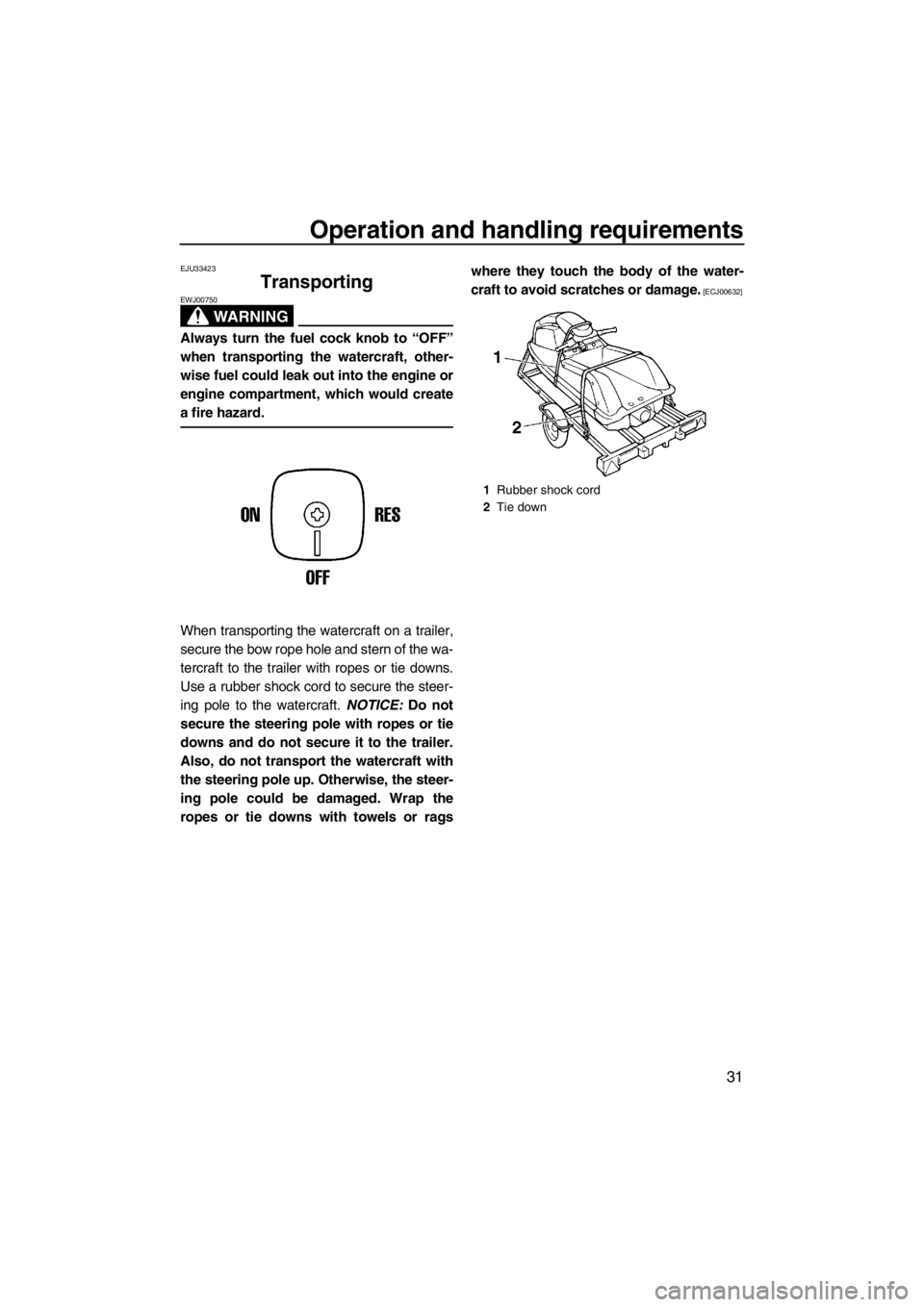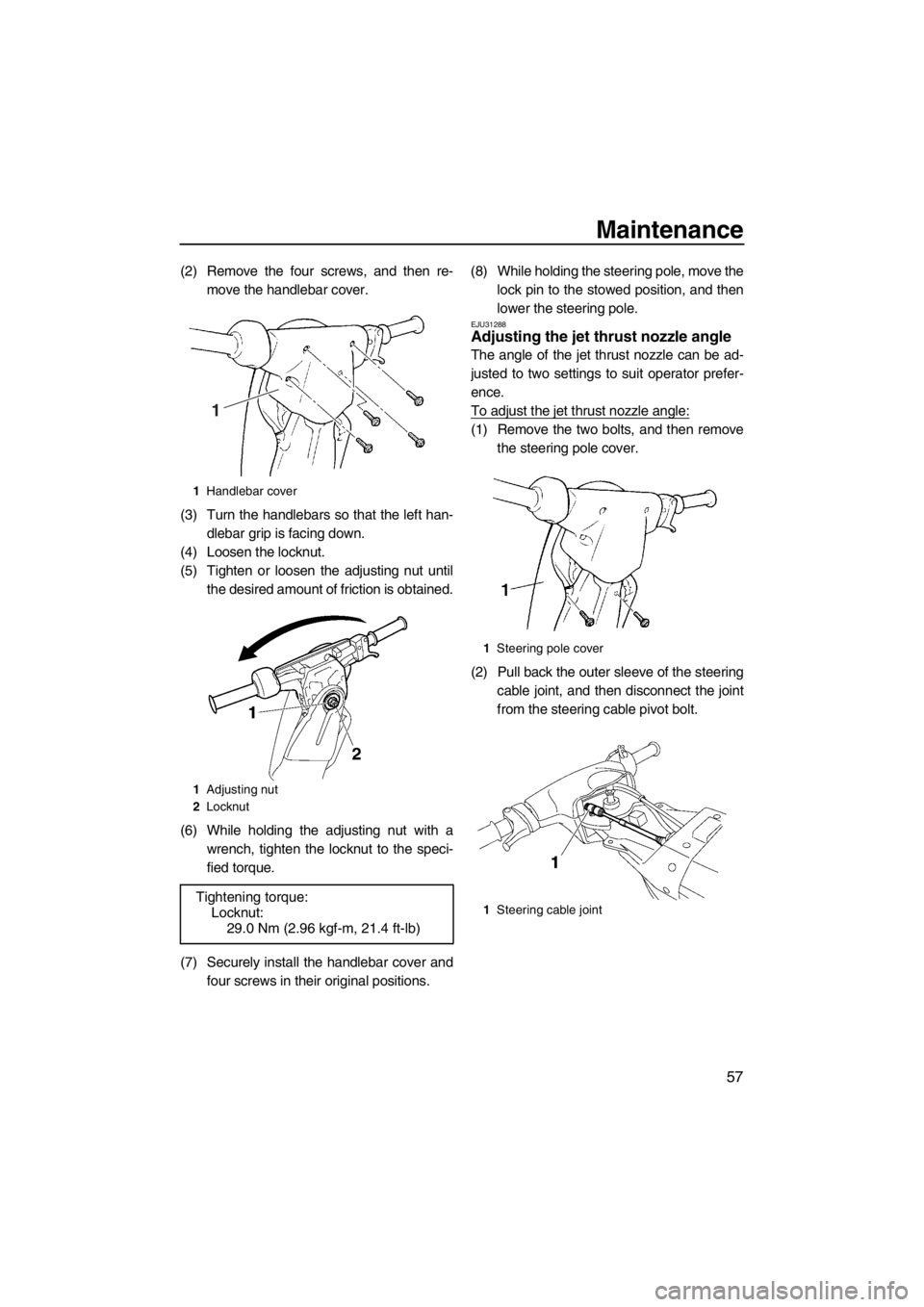2013 YAMAHA SUPERJET tow
[x] Cancel search: towPage 6 of 78

Table of contents
Capsized watercraft ......................... 48
Beaching the watercraft ................... 49
Operating in weeded areas ............. 49
After removing the watercraft from the water ...................................... 49
Care and storage ............................. 50Post-operation care ...................... 50
Flushing the cooling water
passages ...................................... 50
Cleaning the watercraft ................... 51
Battery care ..................................... 51
Long-term storage ........................ 54
Cleaning .......................................... 54
Lubrication ....................................... 54
Rustproofing .................................... 55
Maintenance..................................... 56 Maintenance ................................. 56
Tool kit ............................................. 56
Adjusting the steering friction .......... 56
Adjusting the jet thrust nozzle
angle ............................................ 57
Periodic maintenance chart ............. 59
Checking the spark plugs ................ 60
Lubrication points ............................ 61
Checking the fuel filter ..................... 61
Adjusting the choke cable ............... 61
Adjusting the carburetor .................. 62
Specifications .................................. 63 Specifications ................................ 63
Trouble recovery ............................. 64 Troubleshooting ........................... 64
Troubleshooting chart ...................... 64
Emergency procedures ................ 66
Cleaning the jet intake and
impeller ........................................ 66
Jumping the battery ......................... 67
Replacing the fuse ........................... 67
Towing the watercraft ...................... 68
Submerged watercraft ..................... 68
UF2F75E0.book Page 2 Thursday, July 5, 2012 8:50 AM
Page 18 of 78

Safety information
12
●Avoid being hit by another boat. You should
always take the responsibility to watch for
traffic; other boaters may not be watching
for you. If they do not see you, or if you ma-
neuver more quickly than other boaters ex-
pect, you risk a collision.
●Maintain a safe distance from other boats
and watercraft, and also watch for ski ropes
or fishing lines. Obey the “Safe boating
rules” and be sure to check behind you be-
fore making a turn. (See “Safe boating
rules” on page 14.)
EJU30840
Recommended equipment
The following items should be carried on
board your watercraft:
●Sound-signaling device
You should carry a whistle or other sound-
signaling device that can be used to signal
other boats.
●Visual distress signals
It is recommended that a pyrotechnic de-
vice, which is approved by the appropriate
authorities, be stored in a waterproof con-
tainer on your watercraft. A mirror can also
be used as an emergency signal. Contact a
Yamaha dealer for more information.
●Watch
A watch is helpful so you will know how long
you have been operating the watercraft.
●Towline
A towline can be used to tow a disabled wa-
tercraft in an emergency.
UF2F75E0.book Page 12 Thursday, July 5, 2012 8:50 AM
Page 31 of 78

Equipment operation
25
To install the hood:
(1) Position the hood on the deck so that thetwo projections at the front of the hood fit
under the two stays on the deck.
(2) Push down on the hood latch, and then turn the knob to the “LOCK” position to
securely lock the hood in place.
(3) While holding the steering pole, move the lock pin to the stowed position, and then
lower the steering pole.
EJU36002Bow rope hole
The bow rope hole is used to attach a rope to
the watercraft when transporting, mooring, or towing it in an emergency. (See page 68 for
information on towing the watercraft.)
EJU36011Stern rope hole
The stern rope hole is used to attach a rope to
the watercraft when mooring it.
EJU31675Storage pouch
The storage pouch is located on the bottom of
the hood.
Use the storage pouch to store the own-
er’s/operator’s manual, tool kit, and other
small items. The storage pouch is not de-
signed to be waterproof. If you carry objects
that must be kept dry, put them in a water-
proof bag.
To remove the storage pouch:
(1) Remove the hood. (See page 24 for hood
removal and installation procedures.)
LOCKOPEN
1 Bow rope hole
1 Stern rope hole
UF2F75E0.book Page 25 Thursday, July 5, 2012 8:50 AM
Page 33 of 78

Equipment operation
27
(4) Loosen the fire extinguisher containercap and remove it.
To close the fire extinguisher container:
(1) Insert the fire extinguisher into the con- tainer, and then securely install the fire
extinguisher container cap by tightening it
until it stops.
(2) Lower the container on the hood to its storage position and secure it with the
band.
(3) While holding the steering pole, move the lock pin to the stowed position, and then
lower the steering pole.
1Fire extinguisher container cap
UF2F75E0.book Page 27 Thursday, July 5, 2012 8:50 AM
Page 37 of 78

Operation and handling requirements
31
EJU33423
Transporting
WARNING
EWJ00750
Always turn the fuel cock knob to “OFF”
when transporting the watercraft, other-
wise fuel could leak out into the engine or
engine compartment, which would create
a fire hazard.
When transporting the watercraft on a trailer,
secure the bow rope hole and stern of the wa-
tercraft to the trailer with ropes or tie downs.
Use a rubber shock cord to secure the steer-
ing pole to the watercraft. NOTICE: Do not
secure the steering pole with ropes or tie
downs and do not secure it to the trailer.
Also, do not transport the watercraft with
the steering pole up. Otherwise, the steer-
ing pole could be damaged. Wrap the
ropes or tie downs with towels or rags where they touch the body of the water-
craft to avoid scratches or damage.
[ECJ00632]
1
Rubber shock cord
2 Tie down
UF2F75E0.book Page 31 Thursday, July 5, 2012 8:50 AM
Page 55 of 78

Operation
49
see “Towing the watercraft” on page 68
or “Submerged watercraft” on page 68.)
NOTICE: Do not run the engine at full
throttle for at least 1 minute after the
engine has been restarted. Bilge water
in the engine compartment can splash
into the engine, which can result in se-
vere damage.
[ECJ00553]
EJU33302
Beaching the watercraft
To beach the watercraft:
(1) Make sure that there are no boats, swim- mers, or obstacles near the beach.
(2) Release the throttle lever to reduce speed about 90 m (300 ft) before you
reach the intended beaching area.
(3) Slowly approach the beach and stop the engine just before reaching land.
WARNING! You need throttle to steer. Shutting the engine off can cause you
to hit an obstacle you are attempting
to avoid. A collision could result in se-
vere injury or death.
[EWJ00601] NOTICE:
Never run the engine in water that is
less than 60 cm (2 ft) deep from the
bottom of the watercraft, otherwise
pebbles or sand could be sucked into
the jet intake, causing impeller dam-
age and engine overheating.
[ECJ00472]
(4) Get off the watercraft and pull it up on the beach.
EJU37193Operating in weeded areas
Always avoid using your watercraft in areas
where weed growth is thick. If operating in
weeded areas is unavoidable, alternately
squeeze the throttle lever and relax your grip
on the throttle lever to vary the engine speed.
Weeds tend to become clogged more when
operating at a steady speed and at trolling
speed. If weeds may have clogged the intake area, clean the jet intake. (See page 66 for in-
formation on the jet intake.)
EJU41060After removing the watercraft from the
water
NOTICE
ECJ01360
Do not run the engine for more than 15
seconds on land without supplying water,
otherwise the engine could overheat.
After operating and removing the watercraft
from the water, promptly discharge the re-
maining water from the cooling water passag-
es.
To discharge water from the cooling water
passages:
(1) Make sure that the area around the wa-
tercraft is clear, and then start the engine.
(2) Discharge the remaining water out of the cooling water passages by alternately
squeezing and releasing the throttle lever
quickly for 10 to 15 seconds.
(3) Stop the engine.
UF2F75E0.book Page 49 Thursday, July 5, 2012 8:50 AM
Page 63 of 78

Maintenance
57
(2) Remove the four screws, and then re-move the handlebar cover.
(3) Turn the handlebars so that the left han- dlebar grip is facing down.
(4) Loosen the locknut.
(5) Tighten or loosen the adjusting nut until the desired amount of friction is obtained.
(6) While holding the adjusting nut with a wrench, tighten the locknut to the speci-
fied torque.
(7) Securely install the handlebar cover and four screws in their original positions. (8) While holding the steering pole, move the
lock pin to the stowed position, and then
lower the steering pole.
EJU31288Adjusting the jet thrust nozzle angle
The angle of the jet thrust nozzle can be ad-
justed to two settings to suit operator prefer-
ence.
To adjust the jet thrust nozzle angle:
(1) Remove the two bolts, and then removethe steering pole cover.
(2) Pull back the outer sleeve of the steering cable joint, and then disconnect the joint
from the steering cable pivot bolt.
1Handlebar cover
1 Adjusting nut
2 Locknut
Tightening torque:
Locknut:29.0 Nm (2.96 kgf-m, 21.4 ft-lb)
1
1Steering pole cover
1 Steering cable joint
UF2F75E0.book Page 57 Thursday, July 5, 2012 8:50 AM
Page 74 of 78

Trouble recovery
68
(4) Open the fuse holder and replace thefuse with one of the correct amperage.
WARNING! Do not use fuses of a dif- ferent amperage than recommended.
Substitution with a fuse that has an
improper rating can cause extensive
electrical system damage and possi-
ble fire.
[EWJ00802]
(5) Insert the fuse holder into the electrical box.
(6) Securely install the cap by tightening it until it stops.
(7) Securely install the hood in its original po- sition.
EJU34704Towing the watercraft
WARNING
EWJ00811
●The operator of the towing boat must
keep speed to a minimum and avoid traf-
fic or obstacles which could be a hazard
to the operator on the watercraft.
●The towline should be long enough so
that the watercraft will not collide with
the towing boat when slowing down.
If the watercraft becomes inoperative in the
water, it can be towed to shore.
To tow the watercraft:
Use a towline that is three times the combined
length of the towing boat and the watercraft.
(1) Securely attach the towline to the bowrope hole of the watercraft being towed.
(2) Ride the watercraft with your body weight supported on the riding tray. Hold on to
the handlebars in order to balance the
watercraft and keep the bow up out of the
water. NOTICE: The bow must be kept
up out of the water during towing, oth-
erwise water could flood the engine
compartment or water could flow back
into the engine, causing severe en-
gine damage.
[ECJ01330]
Tow the watercraft at 8 km/h (5 mph) or less.
NOTICE: Tow the watercraft at 8 km/h (5
mph) or less, otherwise water could flood
the engine compartment or water could
flow back into the engine, causing severe
engine damage.
[ECJ01321]
EJU34734
Submerged watercraft
If the watercraft is submerged or flooded with
water, drain the bilge water from the engine
1 Fuse holder
2 Electrical box
3 Fuse
4 Cap
Fuse amperage:
Battery fuse:10 A
1Bow rope hole
UF2F75E0.book Page 68 Thursday, July 5, 2012 8:50 AM